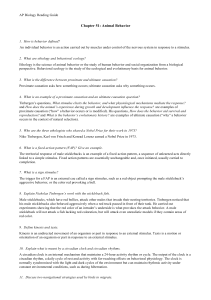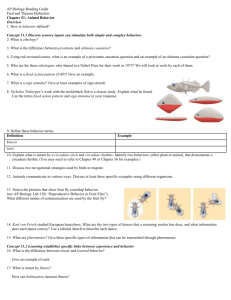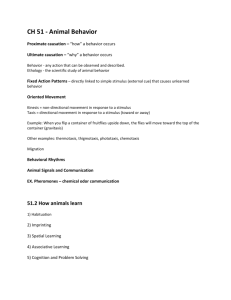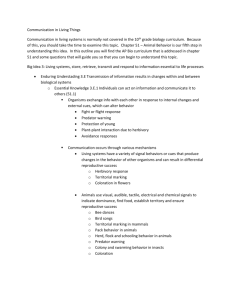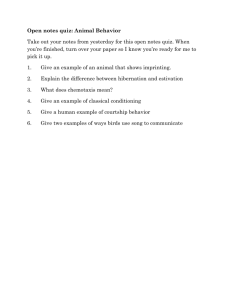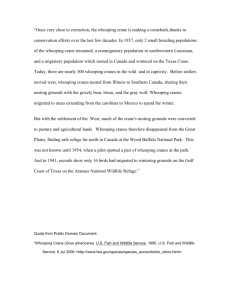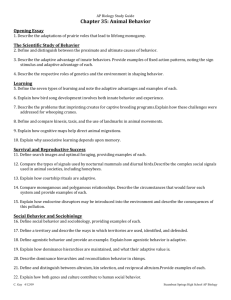Chapter 51: Animal Behavior - Biology E
advertisement
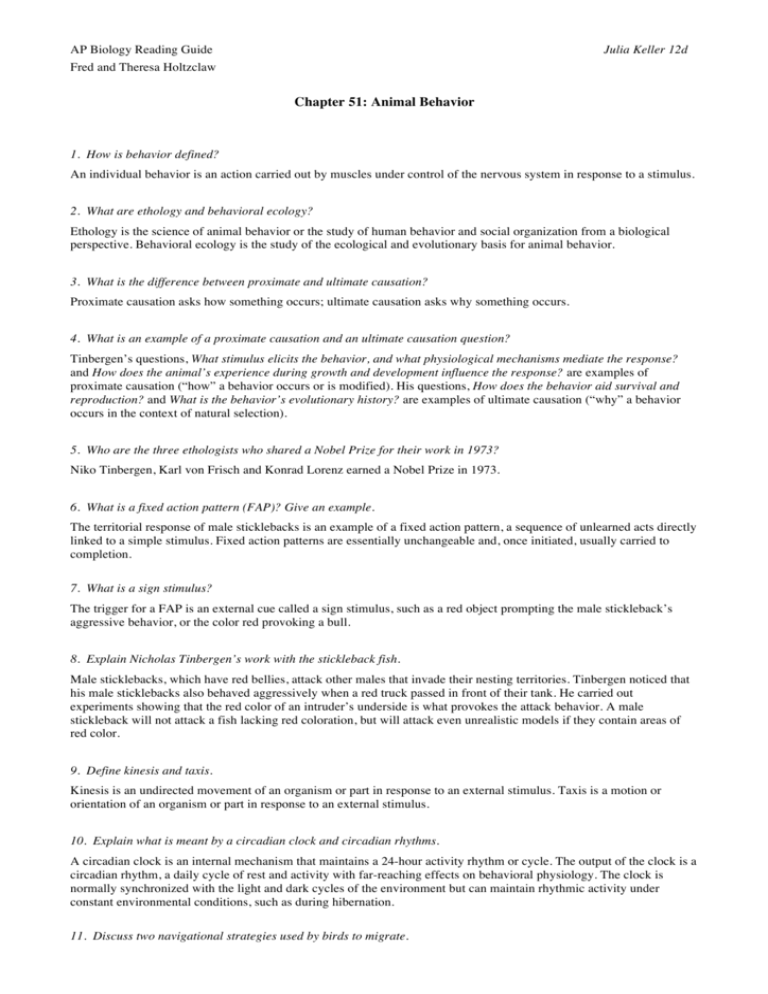
AP Biology Reading Guide Fred and Theresa Holtzclaw Julia Keller 12d Chapter 51: Animal Behavior 1. How is behavior defined? An individual behavior is an action carried out by muscles under control of the nervous system in response to a stimulus. 2. What are ethology and behavioral ecology? Ethology is the science of animal behavior or the study of human behavior and social organization from a biological perspective. Behavioral ecology is the study of the ecological and evolutionary basis for animal behavior. 3. What is the difference between proximate and ultimate causation? Proximate causation asks how something occurs; ultimate causation asks why something occurs. 4. What is an example of a proximate causation and an ultimate causation question? Tinbergen’s questions, What stimulus elicits the behavior, and what physiological mechanisms mediate the response? and How does the animal’s experience during growth and development influence the response? are examples of proximate causation (“how” a behavior occurs or is modified). His questions, How does the behavior aid survival and reproduction? and What is the behavior’s evolutionary history? are examples of ultimate causation (“why” a behavior occurs in the context of natural selection). 5. Who are the three ethologists who shared a Nobel Prize for their work in 1973? Niko Tinbergen, Karl von Frisch and Konrad Lorenz earned a Nobel Prize in 1973. 6. What is a fixed action pattern (FAP)? Give an example. The territorial response of male sticklebacks is an example of a fixed action pattern, a sequence of unlearned acts directly linked to a simple stimulus. Fixed action patterns are essentially unchangeable and, once initiated, usually carried to completion. 7. What is a sign stimulus? The trigger for a FAP is an external cue called a sign stimulus, such as a red object prompting the male stickleback’s aggressive behavior, or the color red provoking a bull. 8. Explain Nicholas Tinbergen’s work with the stickleback fish. Male sticklebacks, which have red bellies, attack other males that invade their nesting territories. Tinbergen noticed that his male sticklebacks also behaved aggressively when a red truck passed in front of their tank. He carried out experiments showing that the red color of an intruder’s underside is what provokes the attack behavior. A male stickleback will not attack a fish lacking red coloration, but will attack even unrealistic models if they contain areas of red color. 9. Define kinesis and taxis. Kinesis is an undirected movement of an organism or part in response to an external stimulus. Taxis is a motion or orientation of an organism or part in response to an external stimulus. 10. Explain what is meant by a circadian clock and circadian rhythms. A circadian clock is an internal mechanism that maintains a 24-hour activity rhythm or cycle. The output of the clock is a circadian rhythm, a daily cycle of rest and activity with far-reaching effects on behavioral physiology. The clock is normally synchronized with the light and dark cycles of the environment but can maintain rhythmic activity under constant environmental conditions, such as during hibernation. 11. Discuss two navigational strategies used by birds to migrate. Some migrating animals track their position relative to the sun, even though the sun’s position relative to Earth changes throughout the day. Animals can adjust for these changes by means of a circadian clock. If the sky is overcast, many species of birds can also sense their position relative to Earth’s magnetic field and thereby navigate without solar or celestial cues. Some scientists hypothesize that Earth’s pull on magnetite-containing structures in the heads of migrating fishes and birds triggers transmission of nerve impulses to the brain. Others propose that migrating animals are guided by the effects of Earth’s magnetic field on photoreceptors in the eye. 12. Discuss at least three specific examples of the various ways in which animals communicate. When a male fruit fly sees and turns toward a female fruit fly, he relies on visual communication. In addition, his olfactory system detects chemicals released into the air by the female via chemical communication. Having recognized the female, the male approaches and taps the female with a foreleg. This touching, or tactile communication, alerts the female to the male’s presence. In the third stage of courtship, the male extends and vibrates his wing, producing a specific courtship song. This singing, an example of auditory communication, informs the female that the male is of the same species. 13. What different modes of communication are used by the fruit fly? The fruit fly uses visual, chemical, tactile, and auditory modes of communication. 14. What are the two types of dances that a worker bee does, and what information does each dance convey? ! Methodical recordings of bee movements enabled von Frisch to decipher a “dance language” that returning foragers use to inform other bees about the distance and direction of travel to food sources. The round dance indicates that food is near. The waggle dance, performed when food is distant, indicates distance by the number of abdominal waggles performed in the straight-run part of the dance. Direction is indicated by the angle (in relation to the vertical surface of the hive) of the straight run. 15. What are pheromones? Give three specific types of information that can be transmitted through pheromones. Animals that communicate through odors or tastes emit chemical substances called pheromones. Pheromones can trigger specific courtship behaviors, serve as alarm signals, and maintain social order. For instance, one pheromone once called the queen substance attracts worker bees to the queen, inhibits development of ovaries in workers, and attracts males (drones) to the queen during her mating flights out of the hive. 16. What is the difference between innate and learned behavior? Give an example of each. For many behaviors, such as a FAP, a courtship stimulus-response chain, and pheromone signaling, nearly all individuals in a population exhibit virtually the same behavior, despite internal and environmental differences during development and throughout life. Behavior that is developmentally fixed this way is known as innate behavior. In other cases, behavior is variable, depending on experience. Learning is the modification of behavior based on specific experiences. 18. Describe the process of imprinting and explain what is meant by sensitive or critical period. Imprinting, the formation at a specific stage in life of long-lasting behavioral response to a particular individual or object, includes both learned and innate components. Imprinting is distinguished from other types of learning by having a sensitive (critical) period, a limited developmental phase when this type of learning can occur. During the critical period, the young imprint on their parent and learn the basic behaviors of their species, while the parent learns to recognize its offspring. 19. Describe the classic study of parental imprinting done by Konrad Lorenz. In classic experiments in the 1930s, Lorenz showed that the principal imprinting stimulus in graylag geese is a nearby object that is moving away from the young. When incubator-hatched goslings spent their first few hours with Lorenz rather than with a goose, they imprinted on him and steadfastly followed him from then on. Furthermore, they showed no recognition of their biological mother or other adults of their own species. 20. What special challenges did researchers face in order to return whooping cranes to the wild? Scientists tried raising endangered whooping cranes in captivity by using sandhill cranes as foster parents. However, because the whooping cranes imprinted on their foster parents, none formed a pair-bond with a whooping crane mate. To avoid such problems, captive breeding programs now isolate young cranes. Scientists made further use of imprinting to teach cranes born in captivity to migrate along safe routes. Young whooping cranes are imprinted on humans in “crane suits” and then allowed to follow these “parents” as they fly ultra-light aircraft along selected migration routes. Importantly, these cranes still form mating pair-bonds with other whooping cranes, indicating that the crane costumes have the features required to direct “normal” imprinting. 21. What occurs in spatial learning? Spatial learning is the establishment of a memory that reflects the environment’s spatial structure. 22-23. What are two types of associative learning? The ability to associate one environmental feature (such as color) with another (such as taste) is called associative learning. In classical conditioning, an arbitrary stimulus becomes associated with a particular outcome. Russian physiologist Ivan Pavlov demonstrated that if he always rang a bell just before feeding a dog, the dog would eventually salivate when the bell sounded, anticipating food. In operant conditioning, also called trial-and-error learning, an animal first learns to associate one of its behaviors with a reward or punishment and then tends to repeat or avoid that behavior. Skinner explored this process by having a rat learn through trial and error to obtain food by pressing a lever. 24. What is cognition? Give three examples of cognition in animal species. Cognition is the process of knowing that involves awareness, reasoning, recollection, and judgment. Remarkably, research published in 2010 indicates that honeybees can also learn to distinguish between human faces. Problem solving is the cognitive activity of devising a method to proceed from one state to another in the face of real or apparent obstacles. Maze experiments provide strong evidence that honeybees can distinguish on the basis of “same” and “different.” If a chimpanzee is placed in a room with several boxes on the floor and a banana hung high out of reach, the chimp can stack the boxes, enabling it to reach the food. In one study, one (but not all) ravens confronted with food hanging from branch by a string flew to the branch and alternately pulled up and stepped on the string until the food was within reach. 25. What will happen if a white-crowned sparrow does not hear the song of its species during the critical period? If a fledgling sparrow is prevented from hearing real sparrows or recordings of sparrow songs during the first 50 days of its life, it fails to develop the adult song of its species. Although the young bird does not sing during the critical period, it memorizes the song of its species by listening to other white-crowned sparrows sing. 26. Based on cross-fostering and human twin studies, what are the two factors that contribute significantly to behavior? These investigations have revealed that both genetics and environment contribute significantly to behavior. 27. Discuss the effect of genetically manipulating the fru gene. A single gene called fru controls the male fruit fly’s entire courtship ritual. If the fru gene is mutated to an inactive form, males do not court or mate with females. Normal male and female flies express distinct forms of the fru gene. When females are genetically manipulated to express the male form of fru, they court other females, performing the role normally played by the male. Fru is a master regulatory gene that directs the expression and activity of many genes with narrower functions. 28. What is foraging behavior? Food-obtaining behavior, or foraging, includes not only eating but also any activities an animal uses to search for, recognize, and capture food items. 29. What is proposed by the optimal foraging model? According to this model, natural selection should favor a foraging behavior that minimizes the costs of foraging and maximizes the benefits. The higher a crow flies, the greater the force with which its sea snail prey strikes the rocks when dropped, increasing the chance its shell will break. Flying higher, however, means consuming more energy. Mule deer feed predominantly in open areas. Since food available for mule deer is fairly uniform across the potential foraging areas, although somewhat lower in open, nonforested areas, but predators killed large numbers of mule deer at forest edges and only a small number in open areas and forest interiors, it appears that mule deer foraging behavior reflects the large variation in predation risk and not the smaller variation in food availability. Thus, behavior typically reflects a compromise between competing selective pressures. 30. Describe a food source that you would not be likely to exploit. I would be unlikely to hunt a wild boar in the Grunewald if I could have pizza delivered to my door instead. 31. Explain promiscuity, monogamy, polygamy, polygyny, and polyandry. In promiscuous mating, there are no strong pair-bonds. In species in which the mates remain together for a longer period, the relationship may be monogamous (one male mating with one female) or polygamous (an individual of one sex mating with several of the other). Polygamous relationships most often involve a single male and many females, a system called polygyny, although some species exhibit polyandry, in which a single female mates with several males. 32. Explain two factors that may be important in determining the evolution of mating systems. The needs of the young are an important factor constraining the evolution of mating systems. Most newly hatched birds cannot care for themselves. Rather, they require a large, continuous food supply, a need that is difficult for a single parent to meet. In such cases, a male that stays with and helps a single mate may ultimately have more viable offspring than it would by going off to seek additional mates. This may explain why most birds are monogamous. In the case of mammals, the lactating female is often the only food source for the young; males usually play no role in raising the young. Young born to or eggs laid by a female definitely contain that female’s genes. However, paternity is less certain. The certainty of paternity is relatively low in most species with internal fertilization. This could explain why exclusively male parental care is rare in bird and mammal species. Males of many species with internal fertilization engage in behaviors that appear to increase their certainty of paternity, including guarding females, removing any sperm from the female reproductive tract before copulation, and introducing large quantities of sperm that displace the sperm of other males. 33. What is sexual selection? The degree of sexual dimorphism within a species results from sexual selection, a form of natural selection in which differences in reproductive success among individuals are a consequence of differences in mating success. 34. Explain intersexual and intrasexual selection. In intersexual selection, members of one sex choose mates on the basis of characteristics of the other sex, such as courtship songs. Intrasexual selection involves competition between members of one sex for mates. 35. What is agonistic behavior? Give an original example. Agonistic behavior is an often ritualized contest that determines which competitor gains access to a resource, such as food or mates, as demonstrated by confrontations between snakes. 36. What is altruism? Altruism (“selflessness”) describes a behavior that reduces an animal’s individual fitness but increases the fitness of other individuals in the population. 37. Explain the evolutionary advantage to a population of having members who exhibit altruistic behavior. When parents sacrifice their own well-being to produce and aid offspring, this actually increases the fitness of the parents because it maximizes their genetic representation in the population. William Hamilton proposed that an animal could increase its genetic representation in the next generation by “altruistically” helping close relatives other than its own offspring. 38. Explain altruistic behavior using the concept of inclusive fitness. Inclusive fitness is the total effect an individual has on proliferating its genes by producing its own offspring and by providing aid that enables other close relatives, who share many of those genes, to produce offspring. 39. Explain geneticist J.B.S. Haldane’s comment that he would lay down his life for two brothers or eight cousins. Kin selection weakens with hereditary distance. If the benefit to the recipient, B, is the average number of extra offspring that the beneficiary of an altruistic act produces, and the cost, C, is how many fewer offspring the altruist produces, then the coefficient of relatedness, r, equals the fraction of genes that, on average, are shared. According to Hamilton’s rule, natural selection favors altruism when the benefit to the recipient multiplied by the coefficient of relatedness exceeds the cost to the altruist; in other words, when rB > C. Siblings have an r of 0.5, but between an aunt and her niece, r = 0.25, and between first cousins, r = 0.125. As the degree of relatedness decreases, the rB term in the Hamilton inequality also decreases. 40. Contrast kin selection and reciprocal altruism. The natural selection that favors altruistic behavior by enhancing reproductive success of relatives is called kin selection. A sort of exchange of aid whereby the aided individual returns the favor in the future, called reciprocal altruism, is commonly invoked to explain altruism that occurs between unrelated humans. Reciprocal altruism is rare in other animals; it is limited largely to species (such as chimpanzees) with social groups stable enough that individuals have many chances to exchange aid. In the tit-for-tat strategy, an individual treats another in the same way it was treated the last time they met.
